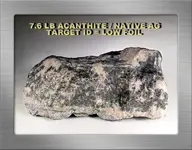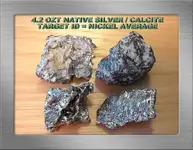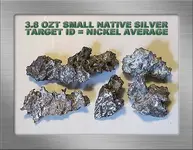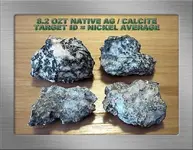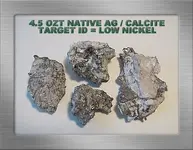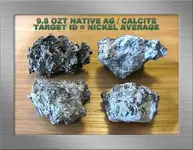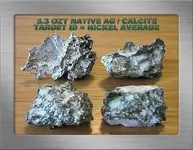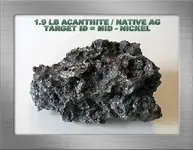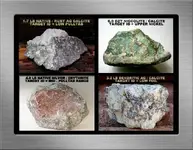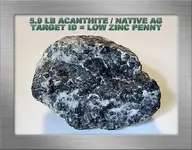Jim Hemmingway
Hero Member
Collecting Native Silver & Related Minerals in Northeastern Ontario’s Silverfields
Introduction…
I’ve been cleaning and photographing some small native silver specimens that were found with a metal detector during my last few rockhounding visits to the silverfields of northeastern Ontario. They are commonplace examples of small silver that hobbyists can anticipate recovering from the tailing disposal areas of abandoned minesites, ranging in size from one-half to several troy ounces.
The information and silver photos presented below may interest newcomers to the fascinating hobby of rock, gem and mineral collecting, particularly for those who have reasonable access to collecting sites for native silver and associated minerals such as the example displayed below. It is comprised primarily of rich, dendritic acanthite with some minor inclusions of native silver visible on the surface.
Searching for Small Silver…
When selecting an appropriate prospecting-capable metal detector for this application, consider the field conditions where you will be operating it. A large portion of your time will involve searching abandoned minesite tailing disposal areas because these sites offer you the best opportunity to find native silver and related minerals.
(a) At many sites ferromagnetic susceptible substrates can be characterized as ranging from light to moderate, and will have little effect on a VLF detector’s ability to function effectively. But some areas, for example diabase dominant substrates, exhibit more elevated magnetic susceptibilities that to some extent will reduce a VLF metal detector’s detection depth and sensitivity, target ID accuracy, and discrimination reliability.
The effects of harsh ground mineralization can be somewhat mitigated by operating a VLF metal detector in a true motion all-metal mode to maximize detection depth and sensitivity to targets. A smaller / DD coil will reduce the ground mineral footprint scanned by the detector, permitting the use of higher gain / sensitivity levels than would otherwise be possible. Regardless of target ID or the absence of it, ensure that all weak signals are investigated until the source is identified.
An obvious alternative strategy to improve detection depth is to use a suitable PI detector for searching more difficult ferromagnetic ground mineral areas. A more recent Minelab PI model will ensure the best possible detection depth over such ground.
(b) Consider the most frequent size of the silver you can expect to find with a metal detector. The small silver depicted in the accompanying photos is representative, and as noted above, range from about one-half to several troy ounces. They are typically larger coin-size targets detectable to very good depths, but keep in mind when choosing a suitable prospecting-capable VLF detector that most small silver is low conductive, and on average is characterized by a nickel target ID.
(c) In some areas conductive pyrrhotite hotrocks are a real nuisance to both VLF and to PI detectors. Abundant pyrrhotite can render specific sites unsuitable for metal detecting. Target ID ranges from iron to low foil, with most pyrrhotite signals eliminated by upper iron range discrimination. My PI units, the Garrett Infinium and White’s TDI Pro, both generate enticing low conductive signals to solidly structured pyrrhotite, and similar to small, low conductive native silver, pyrrhotite PI signals must be dug.
(d) Mining country, and abandoned mining camps in particular, are littered with iron trash of all sizes and description. Small, low conductive iron signals can be eliminated with suitable VLF iron range discrimination, but most non-descript small iron produces low conductive signals from my PI units. Similar to pyrrhotite, our PI units cannot reliably distinguish low conductive silver from low conductive ferrous trash. All low conductive PI signals therefore must be dug, and to do so is prudent fieldcraft regardless which PI brand or model is utilized for this detector-prospecting application.
Incidentally, the same observation largely applies to VLF target ID reliability over deeper, weak target signals in more difficult ferromagnetic substrate conditions. Such signals tend to produce questionable readouts that either frequent or reside within the iron target ID range. To have any confidence in VLF target ID, it is necessary to remove surface material from deeper target signals until a reasonably strong VLF detection signal can be obtained. If any doubt about target ID remains, dig it to be absolutely certain of its identity.
By comparison to low conductive iron, big compact iron such as larger drill bits and milling balls, and sizeable elongated iron such as broken pipes and implements, rail spikes, and drill rods tend to VLF target ID in the non-ferrous range. My PI units produce high conductive signals to large compact iron. A similar response, usually a double low-high or single low-high-low signal, is produced as the coil is swept lengthwise on elongated iron, whereas low conductive signals are normally produced when the coil is swept across the length of such targets. With native silver’s variable conductive potential (variations in size, shape, purity, structure) quite capable of producing both high and low conductive PI signals, the foregoing explains why all PI signals should be identified.
While a large portion of our fieldwork in the northeastern Ontario silverfields is more suitably addressed with VLF units, we frequently use a ground-balancing PI unit for general scanning over tough ferromagnetic substrates where ferrous trash levels are tolerable. In these conditions we employ larger coils to improve detection depth over what VLF units can achieve. Additionally, our PI units eliminate or reduce most non-conductive iron-mineralized hotrock signals in the area. Such signals can be a particular nuisance when searching diabase dominant substrates with a VLF unit.
Our VLF preference is to use mid-operating frequency range detectors for this application. Mid-frequency units respond reasonably well to both high and low conductive silver, and to weaker signals produced by low conductive particulate and sponge silver. By comparison to high frequency units such as my Goldbug2 for example, they are less vulnerable to elevated ferromagnetic mineralizations, and see both higher conductive targets and larger targets at better depths. Incidentally, low operating frequency units work reasonably well, but are less sensitive to low conductives.
We operate both the mid-frequency White’s MXT and Fisher F75 for motion all-metal mode close-up scanning involved with removing surface material from hillslopes, trenching, sinking testholes, and for detecting excessively trashy areas requiring a discrimination mode, but there are other perfectly acceptable detectors that will perform well at these tasks. Your detector choice ideally should feature a target ID in a threshold-based motion all-metal mode, a discrimination mode, include a manually adjustable full range ground balance, a “fastgrab” ground balance for convenience and to assist with target signal evaluation, and a selection of searchcoil types and sizes.
Which type of metal detector is best suited for this application? We operate the PI and VLF units described above to deal with variable field conditions and objectives, but the VLFs do much of the fieldwork here. Newcomers should begin with a VLF unit that incorporates the features outlined above as a minimum. You may wish to supplement your stock coil with larger and smaller coils to increase your versatility in the field.
Once you have gained some field experience with the conditions as described above, and generally have learned more about collecting silver minerals, you can make a more informed decision as to whether acquiring a suitable prospecting-capable PI unit is a viable choice to satisfy your objectives in the field.
Where to Look for Silver & Other Minerals…
As a general principle regardless of the type of minerals one seeks, successful collecting invariably depends on knowing where to look and a willingness to do serious pick and shovel work. Surprisingly detailed information about where to search for many minerals is readily available online to hobby newcomers, with many collecting sites readily accessible by personal vehicle. On occasion, more remote sites or identified prospects will typically require a short hike.
For example, extensive information about abandoned gold and silver mines can be accessed online, and many current government publications are available to interested hobbyists. My personal favorites include a series entitled Rocks and Minerals for the Collector authored by Ann P. Sabrina, in association with the Geological Survey of Canada. These publications supply practical, useful information pertaining to abandoned minesites throughout Canada. They provide road guides to accessible collecting locations, a brief history of a site’s mining operations, normally include production numbers for more prominent minerals such as cobalt, lead, zinc, nickel, copper, silver and gold, and usually provide a comprehensive list of mineral occurrences for each site.
For casual or recreational prospecting enthusiasts visiting this area with limited time to search for silver ores and nuggets, select abandoned sites that will more likely produce detectable native silver based on past production numbers. You can detect these sites with the certain knowledge that highgrade silver was inadvertently discarded to the tailing disposal and nearby areas, sometimes in considerable quantity. The probability of successfully recovering specimen grade silver is sharply improved compared to searching for outback silver float, obscure prospects, or low production sites.
To improve the likelihood of finding silver, try to identify areas where valuable silver was handled and transported. For example, look for evidence of surface veins, shafts, and storage areas where silver was graded, moved, and sometimes inadvertently misplaced. There are many plainly visible field indications of former mine buildings, mill sites, ore transport routes and abandoned trails.
While quantities of silver were frequently discarded to tailing disposal areas, keep in mind that some highgrade silver was unknowingly included with waste rock for road and other construction projects. Hobbyists have also detected large specimen grade silver that was occasionally lost to spills on steep embankments, washouts, or sharp bends along the transport routes of the time.
Incidentally, we occasionally see examples of careless or halfhearted retrieval techniques when only a few more inches of digging in tough ground would have unearthed quality silver that produced unmistakably solid, tight non-ferrous target signals that could not be mistaken for iron trash. A general suggestion to newcomers is to be thorough in all aspects of your fieldwork, examine abandoned digsites, and dig all questionable target signals until the target is identified.
Briefly About Acanthite…
As a related but slight diversion from the topic of searching for small native silver, depicted below is a small but massively structured example of acanthite / native silver recovered from the Kerr Lake area of northeastern Ontario. While selecting some reasonably photogenic small silver examples, I decided to include it here because valuable acanthite https://www.minfind.com/minsearch-10.html
recoveries are a rather infrequent occurrence in my personal experience and therefore welcome additions to my collection. After some 30+ prospecting seasons, I’ve never detected acanthite as a stand-alone mineral. My acanthite finds have always contained some detectable native silver.
For those unfamiliar with this mineral, acanthite is a dark silver sulfide (Ag2S) approximately comprised of 87% silver and 13% sulfur. Smithsonian Rocks & Minerals describe it as the most important ore of silver. Much of the world’s current silver demand is satisfied as a by-product from the refining of argentiferous (silver-bearing) galena. Galena, a lead sulfide, generally contains some small (< 1%) amount of silver in the form of microscopic acanthite inclusions as an impurity.
Acanthite is occasionally misidentified as argentite by hobbyists, but the correct mineral classification when referring to silver sulfide (Ag2S) at room temperatures is acanthite. Both these silver minerals possess the same chemistry but different crystalline structures. Argentite forms in the cubic (aka isometric) system at temperatures above 177 degrees Centigrade (temperature slightly varies according to reference source). Below that temperature acanthite is the stable form of silver sulfide, and crystallizes in the monoclinic system (Smithsonian Rocks & Minerals 2012 American Edition, Eyewitness Rocks & Minerals 1992 American Edition, Wikipedia).
The transformation of argentite to acanthite at lower temperatures often distorts the crystals to unrecognizable shapes, but some retain an overall cubic crystalline shape. Such crystals are called pseudomorphs (false shapes) because they are actually acanthite crystals in the shape of argentite crystals. Acanthite crystals frequently group together to form attractive dendritic (branching) structures embedded in light-hued carbonate rocks that range from rather intricate to massive.
In the field, try to be visually alert to darker (typically sooty-black) acanthite that may be exposed while digging targets, trenching, or by chance encounters with recently exposed material. For example, the local township occasionally removes tons of tailings for road and other construction projects, resulting in fresh new surfaces for hobbyists to explore.
Prominent Minerals Associated with Native Silver…
Native silver, acanthite, pyrargyrite and proustite ruby silvers, stephanite, and other collectable silver minerals primarily occur in carbonate veins in association with gangue minerals such as quartz, chlorite, fluorite, barite, albite, hematite, magnetite and many other minerals related to relatively shallow epithermal deposits. Attractively structured native silver embedded in light-hued carbonates, or for example in association with other silver minerals such as acanthite and proustite, is highly valued by the mineral collecting community.
For newcomers incidentally, structure refers to how the silver is formed, examples include massive or nuggety formations, plate, disseminate or particulate, sponge, highly crystalline, and various dendritic or branching patterns as illustrated by the native silver example in the multi-photo below.
The native silver in this area is intimately associated with major cobalt-nickel arsenide deposits that include notables or collectibles such as safflorite, cobaltite, nickeline, and skutterudite. A number of these ores, typically arsenides and sulfides, produce perfectly good signals from VLF metal detectors. Solidly structured nickeline (aka niccolite), a nickel arsenide, is a fine example that can generate strong signals from both VLF and PI metal detectors. Moreover, it is not unusual for rockhounders to find surface examples of nickeline with its copper-green surface oxidation annabergite, and cobaltite displaying its pink-to-more infrequent reddish surface oxidation erythrite as depicted below.
A wide variety of additional minerals can be collected from the mine dumps. These include more localized occurrences, for example, allargentum (silver antimonide), titanite (wedge-shaped, vitreous calcium titanium silicate formerly called sphene), native bismuth, chrysotile serpentine (asbestos), rutile (titanium oxide) and breithauptite (nickel antimonide), to more commonplace minerals such as sphalerite, arsenopyrite, chalcopyrite, bornite, galena, marcasite, iron pyrite, and so forth.
A Final Word…
In closing we should point out to interested readers that there has been a resurgence in active exploration for both diamonds and cobaltite minerals in the northeastern Ontario silverfields. The existence of diamonds has been widely known for years, and historically there has been a strong industrial demand for cobaltite for hardening steels and other alloys, paint, ceramic, and glass pigmentation, and in other various chemical manufacturing processes. Apparently now there is increased interest in cobaltite for the manufacture of batteries. Industrial demand notwithstanding, for many years cobaltite has also attracted hobbyists interested in recovering valuable crystals.
I hope that both experienced mineral collectors and hobby newcomers have enjoyed reading about native silver and a few of the more prominent associated minerals in this area. Thanks for spending some time here, good luck with your rock and mineral collecting adventures, perhaps one day it will be our good luck to meet you in the field.
Jim Hemmingway,
October, 2019
Collecting Native Silver & Related Minerals
in Northeastern Ontario’s Silverfields
in Northeastern Ontario’s Silverfields
Introduction…
I’ve been cleaning and photographing some small native silver specimens that were found with a metal detector during my last few rockhounding visits to the silverfields of northeastern Ontario. They are commonplace examples of small silver that hobbyists can anticipate recovering from the tailing disposal areas of abandoned minesites, ranging in size from one-half to several troy ounces.
The information and silver photos presented below may interest newcomers to the fascinating hobby of rock, gem and mineral collecting, particularly for those who have reasonable access to collecting sites for native silver and associated minerals such as the example displayed below. It is comprised primarily of rich, dendritic acanthite with some minor inclusions of native silver visible on the surface.
Searching for Small Silver…
When selecting an appropriate prospecting-capable metal detector for this application, consider the field conditions where you will be operating it. A large portion of your time will involve searching abandoned minesite tailing disposal areas because these sites offer you the best opportunity to find native silver and related minerals.
(a) At many sites ferromagnetic susceptible substrates can be characterized as ranging from light to moderate, and will have little effect on a VLF detector’s ability to function effectively. But some areas, for example diabase dominant substrates, exhibit more elevated magnetic susceptibilities that to some extent will reduce a VLF metal detector’s detection depth and sensitivity, target ID accuracy, and discrimination reliability.
The effects of harsh ground mineralization can be somewhat mitigated by operating a VLF metal detector in a true motion all-metal mode to maximize detection depth and sensitivity to targets. A smaller / DD coil will reduce the ground mineral footprint scanned by the detector, permitting the use of higher gain / sensitivity levels than would otherwise be possible. Regardless of target ID or the absence of it, ensure that all weak signals are investigated until the source is identified.
An obvious alternative strategy to improve detection depth is to use a suitable PI detector for searching more difficult ferromagnetic ground mineral areas. A more recent Minelab PI model will ensure the best possible detection depth over such ground.
(b) Consider the most frequent size of the silver you can expect to find with a metal detector. The small silver depicted in the accompanying photos is representative, and as noted above, range from about one-half to several troy ounces. They are typically larger coin-size targets detectable to very good depths, but keep in mind when choosing a suitable prospecting-capable VLF detector that most small silver is low conductive, and on average is characterized by a nickel target ID.
(c) In some areas conductive pyrrhotite hotrocks are a real nuisance to both VLF and to PI detectors. Abundant pyrrhotite can render specific sites unsuitable for metal detecting. Target ID ranges from iron to low foil, with most pyrrhotite signals eliminated by upper iron range discrimination. My PI units, the Garrett Infinium and White’s TDI Pro, both generate enticing low conductive signals to solidly structured pyrrhotite, and similar to small, low conductive native silver, pyrrhotite PI signals must be dug.
(d) Mining country, and abandoned mining camps in particular, are littered with iron trash of all sizes and description. Small, low conductive iron signals can be eliminated with suitable VLF iron range discrimination, but most non-descript small iron produces low conductive signals from my PI units. Similar to pyrrhotite, our PI units cannot reliably distinguish low conductive silver from low conductive ferrous trash. All low conductive PI signals therefore must be dug, and to do so is prudent fieldcraft regardless which PI brand or model is utilized for this detector-prospecting application.
Incidentally, the same observation largely applies to VLF target ID reliability over deeper, weak target signals in more difficult ferromagnetic substrate conditions. Such signals tend to produce questionable readouts that either frequent or reside within the iron target ID range. To have any confidence in VLF target ID, it is necessary to remove surface material from deeper target signals until a reasonably strong VLF detection signal can be obtained. If any doubt about target ID remains, dig it to be absolutely certain of its identity.
By comparison to low conductive iron, big compact iron such as larger drill bits and milling balls, and sizeable elongated iron such as broken pipes and implements, rail spikes, and drill rods tend to VLF target ID in the non-ferrous range. My PI units produce high conductive signals to large compact iron. A similar response, usually a double low-high or single low-high-low signal, is produced as the coil is swept lengthwise on elongated iron, whereas low conductive signals are normally produced when the coil is swept across the length of such targets. With native silver’s variable conductive potential (variations in size, shape, purity, structure) quite capable of producing both high and low conductive PI signals, the foregoing explains why all PI signals should be identified.
While a large portion of our fieldwork in the northeastern Ontario silverfields is more suitably addressed with VLF units, we frequently use a ground-balancing PI unit for general scanning over tough ferromagnetic substrates where ferrous trash levels are tolerable. In these conditions we employ larger coils to improve detection depth over what VLF units can achieve. Additionally, our PI units eliminate or reduce most non-conductive iron-mineralized hotrock signals in the area. Such signals can be a particular nuisance when searching diabase dominant substrates with a VLF unit.
Our VLF preference is to use mid-operating frequency range detectors for this application. Mid-frequency units respond reasonably well to both high and low conductive silver, and to weaker signals produced by low conductive particulate and sponge silver. By comparison to high frequency units such as my Goldbug2 for example, they are less vulnerable to elevated ferromagnetic mineralizations, and see both higher conductive targets and larger targets at better depths. Incidentally, low operating frequency units work reasonably well, but are less sensitive to low conductives.
We operate both the mid-frequency White’s MXT and Fisher F75 for motion all-metal mode close-up scanning involved with removing surface material from hillslopes, trenching, sinking testholes, and for detecting excessively trashy areas requiring a discrimination mode, but there are other perfectly acceptable detectors that will perform well at these tasks. Your detector choice ideally should feature a target ID in a threshold-based motion all-metal mode, a discrimination mode, include a manually adjustable full range ground balance, a “fastgrab” ground balance for convenience and to assist with target signal evaluation, and a selection of searchcoil types and sizes.
Which type of metal detector is best suited for this application? We operate the PI and VLF units described above to deal with variable field conditions and objectives, but the VLFs do much of the fieldwork here. Newcomers should begin with a VLF unit that incorporates the features outlined above as a minimum. You may wish to supplement your stock coil with larger and smaller coils to increase your versatility in the field.
Once you have gained some field experience with the conditions as described above, and generally have learned more about collecting silver minerals, you can make a more informed decision as to whether acquiring a suitable prospecting-capable PI unit is a viable choice to satisfy your objectives in the field.
Where to Look for Silver & Other Minerals…
As a general principle regardless of the type of minerals one seeks, successful collecting invariably depends on knowing where to look and a willingness to do serious pick and shovel work. Surprisingly detailed information about where to search for many minerals is readily available online to hobby newcomers, with many collecting sites readily accessible by personal vehicle. On occasion, more remote sites or identified prospects will typically require a short hike.
For example, extensive information about abandoned gold and silver mines can be accessed online, and many current government publications are available to interested hobbyists. My personal favorites include a series entitled Rocks and Minerals for the Collector authored by Ann P. Sabrina, in association with the Geological Survey of Canada. These publications supply practical, useful information pertaining to abandoned minesites throughout Canada. They provide road guides to accessible collecting locations, a brief history of a site’s mining operations, normally include production numbers for more prominent minerals such as cobalt, lead, zinc, nickel, copper, silver and gold, and usually provide a comprehensive list of mineral occurrences for each site.
For casual or recreational prospecting enthusiasts visiting this area with limited time to search for silver ores and nuggets, select abandoned sites that will more likely produce detectable native silver based on past production numbers. You can detect these sites with the certain knowledge that highgrade silver was inadvertently discarded to the tailing disposal and nearby areas, sometimes in considerable quantity. The probability of successfully recovering specimen grade silver is sharply improved compared to searching for outback silver float, obscure prospects, or low production sites.
To improve the likelihood of finding silver, try to identify areas where valuable silver was handled and transported. For example, look for evidence of surface veins, shafts, and storage areas where silver was graded, moved, and sometimes inadvertently misplaced. There are many plainly visible field indications of former mine buildings, mill sites, ore transport routes and abandoned trails.
While quantities of silver were frequently discarded to tailing disposal areas, keep in mind that some highgrade silver was unknowingly included with waste rock for road and other construction projects. Hobbyists have also detected large specimen grade silver that was occasionally lost to spills on steep embankments, washouts, or sharp bends along the transport routes of the time.
Incidentally, we occasionally see examples of careless or halfhearted retrieval techniques when only a few more inches of digging in tough ground would have unearthed quality silver that produced unmistakably solid, tight non-ferrous target signals that could not be mistaken for iron trash. A general suggestion to newcomers is to be thorough in all aspects of your fieldwork, examine abandoned digsites, and dig all questionable target signals until the target is identified.
Briefly About Acanthite…
As a related but slight diversion from the topic of searching for small native silver, depicted below is a small but massively structured example of acanthite / native silver recovered from the Kerr Lake area of northeastern Ontario. While selecting some reasonably photogenic small silver examples, I decided to include it here because valuable acanthite https://www.minfind.com/minsearch-10.html
recoveries are a rather infrequent occurrence in my personal experience and therefore welcome additions to my collection. After some 30+ prospecting seasons, I’ve never detected acanthite as a stand-alone mineral. My acanthite finds have always contained some detectable native silver.
For those unfamiliar with this mineral, acanthite is a dark silver sulfide (Ag2S) approximately comprised of 87% silver and 13% sulfur. Smithsonian Rocks & Minerals describe it as the most important ore of silver. Much of the world’s current silver demand is satisfied as a by-product from the refining of argentiferous (silver-bearing) galena. Galena, a lead sulfide, generally contains some small (< 1%) amount of silver in the form of microscopic acanthite inclusions as an impurity.
Acanthite is occasionally misidentified as argentite by hobbyists, but the correct mineral classification when referring to silver sulfide (Ag2S) at room temperatures is acanthite. Both these silver minerals possess the same chemistry but different crystalline structures. Argentite forms in the cubic (aka isometric) system at temperatures above 177 degrees Centigrade (temperature slightly varies according to reference source). Below that temperature acanthite is the stable form of silver sulfide, and crystallizes in the monoclinic system (Smithsonian Rocks & Minerals 2012 American Edition, Eyewitness Rocks & Minerals 1992 American Edition, Wikipedia).
The transformation of argentite to acanthite at lower temperatures often distorts the crystals to unrecognizable shapes, but some retain an overall cubic crystalline shape. Such crystals are called pseudomorphs (false shapes) because they are actually acanthite crystals in the shape of argentite crystals. Acanthite crystals frequently group together to form attractive dendritic (branching) structures embedded in light-hued carbonate rocks that range from rather intricate to massive.
In the field, try to be visually alert to darker (typically sooty-black) acanthite that may be exposed while digging targets, trenching, or by chance encounters with recently exposed material. For example, the local township occasionally removes tons of tailings for road and other construction projects, resulting in fresh new surfaces for hobbyists to explore.
Prominent Minerals Associated with Native Silver…
Native silver, acanthite, pyrargyrite and proustite ruby silvers, stephanite, and other collectable silver minerals primarily occur in carbonate veins in association with gangue minerals such as quartz, chlorite, fluorite, barite, albite, hematite, magnetite and many other minerals related to relatively shallow epithermal deposits. Attractively structured native silver embedded in light-hued carbonates, or for example in association with other silver minerals such as acanthite and proustite, is highly valued by the mineral collecting community.
For newcomers incidentally, structure refers to how the silver is formed, examples include massive or nuggety formations, plate, disseminate or particulate, sponge, highly crystalline, and various dendritic or branching patterns as illustrated by the native silver example in the multi-photo below.
The native silver in this area is intimately associated with major cobalt-nickel arsenide deposits that include notables or collectibles such as safflorite, cobaltite, nickeline, and skutterudite. A number of these ores, typically arsenides and sulfides, produce perfectly good signals from VLF metal detectors. Solidly structured nickeline (aka niccolite), a nickel arsenide, is a fine example that can generate strong signals from both VLF and PI metal detectors. Moreover, it is not unusual for rockhounders to find surface examples of nickeline with its copper-green surface oxidation annabergite, and cobaltite displaying its pink-to-more infrequent reddish surface oxidation erythrite as depicted below.
A wide variety of additional minerals can be collected from the mine dumps. These include more localized occurrences, for example, allargentum (silver antimonide), titanite (wedge-shaped, vitreous calcium titanium silicate formerly called sphene), native bismuth, chrysotile serpentine (asbestos), rutile (titanium oxide) and breithauptite (nickel antimonide), to more commonplace minerals such as sphalerite, arsenopyrite, chalcopyrite, bornite, galena, marcasite, iron pyrite, and so forth.
A Final Word…
In closing we should point out to interested readers that there has been a resurgence in active exploration for both diamonds and cobaltite minerals in the northeastern Ontario silverfields. The existence of diamonds has been widely known for years, and historically there has been a strong industrial demand for cobaltite for hardening steels and other alloys, paint, ceramic, and glass pigmentation, and in other various chemical manufacturing processes. Apparently now there is increased interest in cobaltite for the manufacture of batteries. Industrial demand notwithstanding, for many years cobaltite has also attracted hobbyists interested in recovering valuable crystals.
I hope that both experienced mineral collectors and hobby newcomers have enjoyed reading about native silver and a few of the more prominent associated minerals in this area. Thanks for spending some time here, good luck with your rock and mineral collecting adventures, perhaps one day it will be our good luck to meet you in the field.
Jim Hemmingway,
October, 2019
Upvote
0

